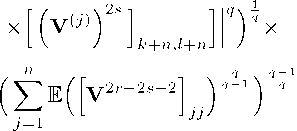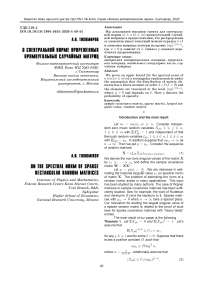О спектральной норме прореженных прямоугольных случайных матриц
Автор: А.Н. Тихомиров
Журнал: Известия Коми научного центра УрО РАН @izvestia-komisc
Статья в выпуске: 4 (44), 2020 года.
Бесплатный доступ
Короткий адрес: https://sciup.org/149129523
IDR: 149129523
Текст статьи О спектральной норме прореженных прямоугольных случайных матриц
Introduction and the main result
Let m = m(n), m ^ n. Consider independent zero mean random variables Xjk, 1 ^ J ^ n, 1 < к ^ m with ^X2k = 1 and independent of that
Bernoulli random variables ^7,4 1 + 3 + n, 1 + к + m with E^ = p^. In addition suppose that npn -4 00 as n -4 00. Then we putp = pn. Consider the sequence of random matrices
ОН THE SPECTRAL ИПНМ HF SPARSE RECTAHGULAR RAHRHM MATRICES
Institute of Physics and Mathematics, Federal Research Centre Komi Science Centre, Ural Branch, RAS, Syktyvkar Higher School of Economics,
National Research University, Moscow
X - (CjfcXjk)l^j^n3^k^m. (1)
We denote the non-zero singular values of the matrix X by si > ■ ■ ■ > s„ and define the sample covariance matrix W = XX*.
Let у = y(n) = ^. We are interesed in estimating the maximal singular value si (or spectral norm) of matrix X. The problem of estimating the norm of a random matrix arises in many applications. This topic has been studied by many authors. The case of Wigner matrices or sample covariance matrices has been sufficiently studied. See, for example, the work of Rudelson and Vershynin [1] and the literature to it. Sparse matrices with pw -4 0 when n -4 00 take a special place. Our motivation for studing the largest singular value of a sparse random matrix is related to the proof of local laws for sparse covariance matrices with "heavy tailed” entries.
The main result of our paper is the following Theorem 1. Let EX,/. = 0 and E|Xy/. |2 = 1. Let’s assume that
E|Xyfc|4+6 < Co < 00, for any j, к ^ 1 and for some 6 > 0. Suppose that there exists a positive constant B, such that npn ^ В log” n, where x = э/д5^)- Additionally assume that
\Xjk\ < C^np^-X (2)
Then for every Q > 1 there exists a constant C = G(Q, d, Co, Ci), such that
Pr{ si > C,/np\/logn} Cn , (3)
The estimations of the largest singular value for s parse covariance matrices like (3) but without factor ■/logn, with stricter restrictions of moments, is possible to find in [2].
Some applications and proof of the main result
To estimate the spectral norm of the matrix X, we introduce the matrix V
О X X* О ’
where О denotes a matrix of the corresponding dimension with zero entries. Note that
XX* О О x*x and
TrWs = 27W2s.
Let’s consider the estimates of the high order moments of the matrix V. First we note that for g = 2r + 1
ETrV9 = 0.
We investigate q = 2r. Let «2k = ^TrV2k.
Theorem 2. The following inequality holds for r ^ С(прУ,
Ea2r< пр У^ Ea2sa2r-2S-2+ s=0
-\-Cnp- —г—E «2г + GE a<2T.
(rip)*
Corollary 1. Under conditions of Theorem 2, for r ^ Co^np^ there exist the constant Ci > 0 depending on Co such that the following inequality holds
Ea2r< СуХпрУ
Proof of Corollary 1 . Let yT = (rip) 2E2ra2r-
Using Young inequality, we can rewrite the result of Theorem 2 as follows уУ ^ _ 4r(l + -——) + r (rip)*
^уУ + ^су^Уу.
Here from we get the required.
□
Corollary 2. There exists an absolute constant C, s.t. for every t> C,
Pr{si ^ lyTTp y\og n \ ^ exp{—clogtlogn}.
Proof of Corollary 2. Note that (np)* > Glogn. We put r = c log n. It is easy to see that si < пттау.
Applying Chebyshev’s inequality, we get
____ Es2r
Pr{si > nEo2r (ripYXognJ'
Using Theorem 2, we get г 1 "(‘r
Pr{si > tTnpVlogn} < <

Lemma 1.
ETW2r = ^ (As + Bs) + Zr s=0
where n mm
A.=E=[EEXjkCjkXji^ji X j = l k=l 1=1
X ((VA)2«1 1 FV2r-2S-21 ,
L J к-\-тг,1-\-тг J L Ajj n m


] k-Vn,j
y=i k=\
Proof of Lemma 1. We have the following equality n m
KT-rV» = 2££e.yx>a- [v2r-‘]t+„J y=l k=l
Let’s denote the jth column of the matrix V for j = 1,... , n by Vj. Let
^j = Xge^ + eyVj - ^__XyyeyeJ and vA=V-A,-. (5)
Using these notations, we obtain
ETrV2r = Ci + C2, where n m
C,i = ££EX,^,fc[vAv2’'-2 j = i k=Y n m j=i k=l
It is straightforward to see that
^-EE^Mdv2-2],.^^.
y=l k=Y
We continue with Gi. Using representation (5), we get
where
= ^^Хэ^эк [(V^V2^3]
к-\-п,з
G12 = ^^EX^fc y = l fe=l
v^AyV2r"3
- J k-Vn,j
Next, it is easy to check that
cn = [v«] [v»-]u = в,.
3=Yk=Y ’
Note that
Gi2 = 0.
We continue with Gn. Applying again representation
(5), we get
Gn — Gin + Gn2,
where
Cui
-EE ^X3^3k [(У^Зу2^4]
3 = 3 k=Y
k+n,j
Cyyi
-EE
k+n,j
Using the definition of Ay, we get
where 72772
=^^x^ke3kWv^^^ x j = Yk=Y x \XMs"^33, 72 772772
^s=^2e[^2 ^2 ^jk^jkXji^jiX j = l k= 1 Z = 1 ,l^k
X Г(У^)2/| 1 rv2r-2s-21
L J /c+72,Z+72 J LJ
Further, we continue with As as follows я^я^+я^, where 72772
T1’=pEe[E[(v°’)2‘]
j=Y k=Y x fv2"-28-2! , J 33
72 772
A^ =^^Х^зк^ 3 = 3 k=Y
X ^(V^)2S1 1 rv2r-2s-21
L J к-\-тг,к-\-тг J L J 33
Using Vkk ^ 0 and Vkk ^ 0 for к = 1,..., n + m and interplacing theorem, we get
A^ < pETrV2sTrV2r-2s-2.
We can rewrite it as
-Я^1) < npEa2sa2r_2s_2. n
Applying Holder inequality, we get 72 772
|Я(2)| < ^^^(x^e3k-Ex^e3k)x j=Y k=Y
n m m
ся = £££ех,Л^ [(vM)2L 3=1k=\ Z=1
x[V2-yjJ = A2.
x (V^)2s

Repeating with Gm, we get
72 772
Gm = Bi + ^^EXy^ [(V^)4V2r"5
Continuing this procedure, we get the required. □
Proof of Theorem 2. We start with the estimation of As, for s = 1,..., k= . We represent
Note that for s = 0,..., [G^] we have q = ^^ > 2. Taking the conditional expectation with respect to V^) and applying Rosenthal’s inequality, we get the inequality
72 772 q
L J k-Vn,k-Vn / / j=Y k=Y
+g9p(np)9-29;J<_2
\ L J k-Vnsk-Vn / /
As = As + AS1

This implies that
I^Kr^ + if), where
Note that

< qpy^yTTV'11'
Г^ = C 2npg 52 E i (
— 1 r 2n

2(r—1)

Further,

< ETW2^"1).
Г^2) = q(riplV-‘2,<-A^4,n-'5 x
n m 2(r—1)
x52E" (52 ([(vM) 4
y=l fe=l
x
J кртг^кртг/ /
xE*?|[v^A]J-.
Applying Holder’s inequality and interlacing theorem, we get rW <27^(ETr(V)2(r-1^ <
^^/npqn^ (ETrV2’’) r ,(6)
Г^2) ^Gg^p)1-2^-^^ (ETr^)2^-1)) <
^Сд^р)1"2^-^^ (ETrV2r) " .(7)
Further, we consider As. Applying twice Holder’s inequality, we get
n
^v(52E|[52 52 хзк<зкХр<рх j = l k=ll = l^l^k

Applying inequality for quadratic forms (see [3]), we get
As< nl (fW + f(2) GT®)" x

where fW =qV^V У Gv22 ) V, \ 7-^ \ L J к-\-пД-\-п/ /
Z=1
1У =qXp% (^ар^-ч^-^рх mm Q q x eV (V Пу22 У2, k=l 1=1 m m ty =y («р^-^-у у y e| У2 I L J /c+n,Z+n k=l1=1
This implies that
УУ q^p^ (np)^~^~^ — (ЕТгУ2’’) r . (10)
Finally,

Moreover,

j=i

Combining the estimates (8)—(10), we get
As ^ Cnp(^ + S2 + S3) (ETr(V)2r) ~ where
Ei =qn-2 + r)
E2 =q2 ^Тгр^-2-^-><+д)тг-2+г^-Т=1)
Summing by s = 1,..., [G^], we get
[V] 1 a 2
As < Cnpn^ —^+t—.i _ + t—x s=0 V Vn (np)2+^^7
x(ETrV2r) r .
Now we estimate Bs. First we note that Bo = 0.
We can assume that s > 1. We represent Bs in the form n m
^s = 52®[52 52 XjiXjk$iji£ijkx y=l k=\l = \,l^j

The estimation of Bs is similar to the estimation of As. We get
IV1 / , 3
„ 1 / r log r r 2
|BS| < Спрп'- —+ -— i +

In conclusion, we estimate ZT. Without loss of generality, we can assume that т is even. First we write

Applying Cauchy inequality, we obtain

xE^y^,/
Taking the conditional expectation and applying Cauchy inequality again, we get


ЧЕЕ1^ьГ)
Z=1
From here it follows that
П / г i2r—2 \ -
\Zr\ < CVp^2 (ЕГг Vм 7=1
Taking into account interlacing theorem and applying Cauchy inequality, we get cv»^ Тт-м2-2 (e ^ £ | [v^z,/)1 < 4 7 = 1 Z=1
Combining inequalities (6), (7), (11), and estimates of corresponding sums, we get the required. □
Proof of Theorem 1 . The proof of Theorem 1 follows now from Corollary 2 by choosing t sufficiently large. □


